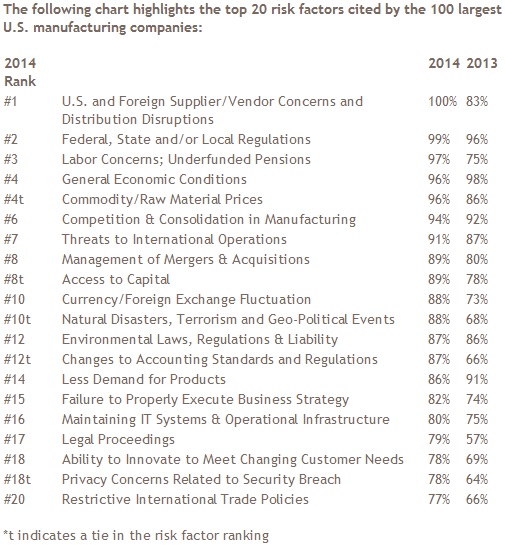BDO: Supply chain and labor top list of risks in manufacturing industry
Skilled worker shortage concerns heightened by industry growth.
In a recent study of 100 top publicly-traded U.S. manufacturers, 100% identified the security and efficiency of supply chain operations as a risk, up from 83% in 2013.
The 2014 BDO Manufacturing RiskFactor Report examines the risk factors in the most recent 10-K filings of the largest 100 publicly traded U.S. manufacturers across five sectors including fabricated metal, food processing, machinery, plastics and rubbers, and transportation equipment. The factors were analyzed and ranked by order of frequency cited.
In the second annual analysis of risk factors, BDO, an accountancy and business advisory firm, found that manufacturers will contend with a number of challenges as they work to capitalize on an improving economy and increased capital spending. In a recent interview, Howard Sosoff, manufacturing and distribution practice leader at BDO, said there is plenty of excellent news for the manufacturing industry.
“But with greater opportunity comes greater challenges,” he said. “Manufacturers will face intense competition this year as they work to attract new orders and workers and expand their capabilities. A shift of focus toward the supply chain is not surprising.”
As U.S. competitiveness increases, Sosoff said, some companies are looking at near-shoring to combat risks of disruption to the supply and the ability to meet demand. Labor is a central component to strengthening a supply chain, even as the usage of automated systems expands. In fact, labor was cited by 97% of manufacturers as a risk this year, up notably from 2013 (75%).
“It’s true that some facilities hardly have any people in them at all, and automation can certainly solve some problems for some people,” Sosoff said, “but the most common theme I hear everywhere I go is a workforce shortage. The challenge is two-fold. As manufacturing expands and evolves, it’s hard to find employees with the right skills. Part two is Baby Boomers retiring. If they can’t find skills for expansion, how will they find skills for replacement?”
Sosoff outlined initiatives from both the ground up and the top down. He cited a National Association of Manufacturers (NAM) program in which plants are opened to students for a day in an effort to “dispel perceptions that this is their grandfather’s manufacturing environment.” More technical training and public education will help, but companies are also making changes to the way they do business.
“We have seen some get creative by using flexible schedules to let employees dictate their own hours,” Sosoff said. “We will see more of that.”
From the top down, Sosoff suggested governments should work to reengineer regulations just as businesses routinely reengineer processes, including purging outdated practices from decades ago. While he pointed to the recent conflict minerals disclosure requirements as an example of impactful new regulations, Sosoff said the primary problem is clutter.
“It’s not any one regulation, but the combination of them all,” he said. “Over the last 50 years, it’s been like building blocks as more regulations just get added.”
Sosoff cited a NAM article that recently estimated it can cost $14,000 per year, per employee for regulatory compliance, compared to $8,000 per employee for non-manufacturing businesses. For smaller manufacturers, it can be as much as $28,000.
Further findings in the 2014 BDO Manufacturing RiskFactor Report:
Manufacturers are increasingly concerned about forecasting errors which could lead to backlogs or shortages, as well as quality issues they may encounter with suppliers. Moreover, 88% of manufacturers note risks related to natural disasters, which could cause transportation breakdowns and significant delays.
Nearly all (99%) cite federal state or local regulation as a risk factor and 87% note concern over accounting standards and regulations, up from 66% in 2013.
Growth in the manufacturing industry is also leading to fierce competition for resources, workers and speed to market. Ninety-four percent of manufacturers cite competition and consolidation as a risk this year, and as seen by the recent Hillshire Farms and Pinnacle deal in the food processing industry, many are turning to acquisitions to gain an edge. More manufacturers (89%, up from 80% in 2013) cite risks related to mergers and acquisitions, a sign that many are looking outside their company to gain access to new technologies, IP, products and distribution channels to improve their market position.
High profile data breaches have businesses in all industries on edge. According to Verizon, the manufacturing industry accounted for less than 1% of security incidents in 2013, but nearly one in four of those incidents involved data loss. While manufacturers store less consumer data than their customers in the retail industry, the protection of intellectual property is crucial, and any loss could threaten manufacturers’ ability to compete effectively. As a result, 78% of manufacturers cite risks related to data security this year, up from 64% in 2013. Moreover, the protection of intellectual property and rising concerns over security are also likely contributing to the increase in manufacturers citing litigation risks (79%, up from 57% in 2013).

Source: 2014 BDO Manufacturing RiskFactor Report












